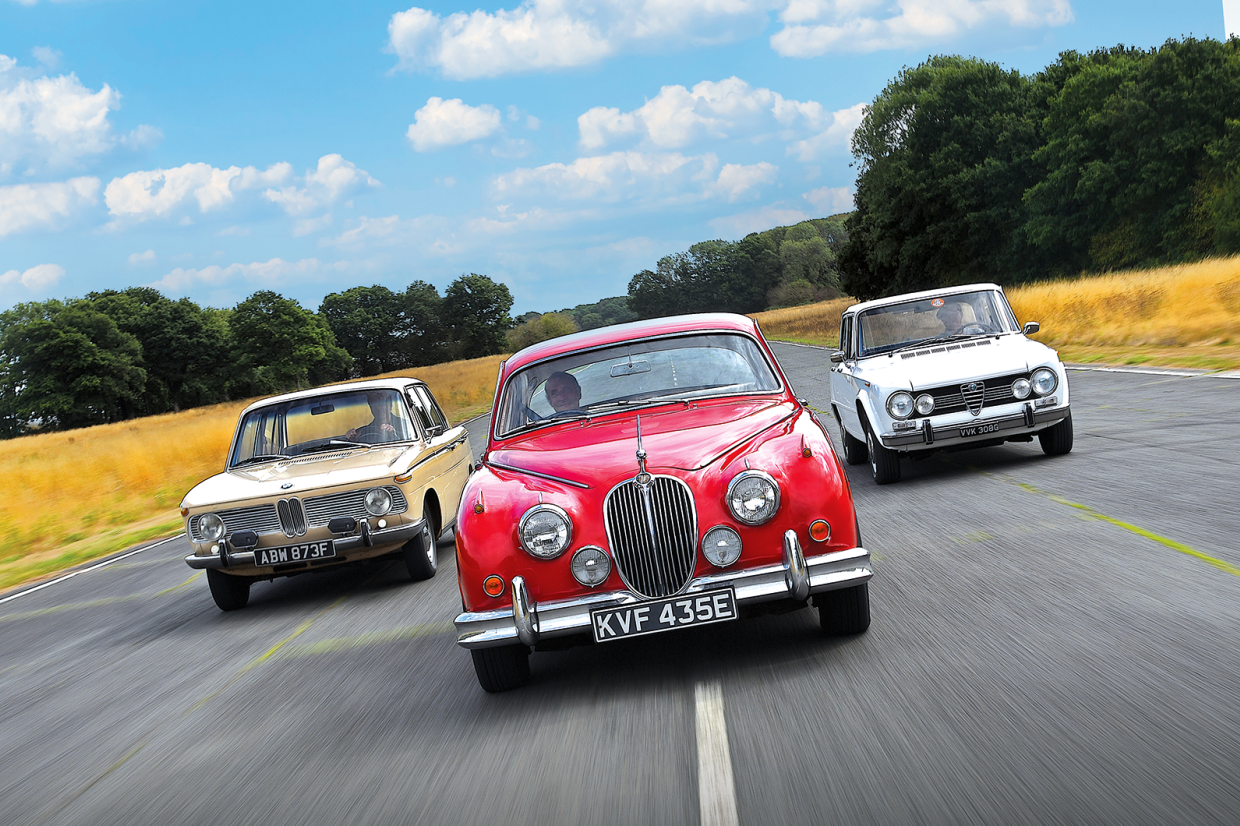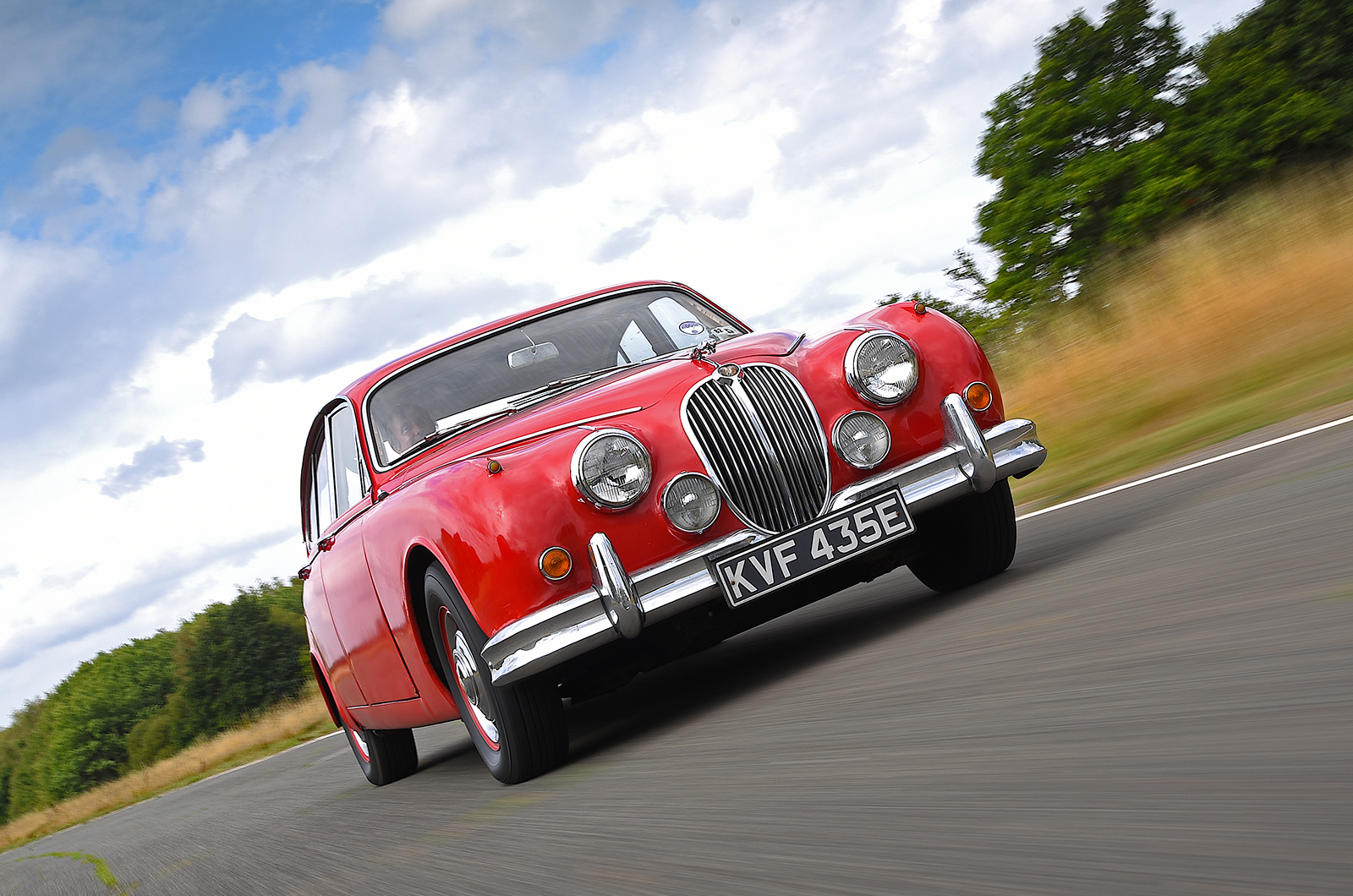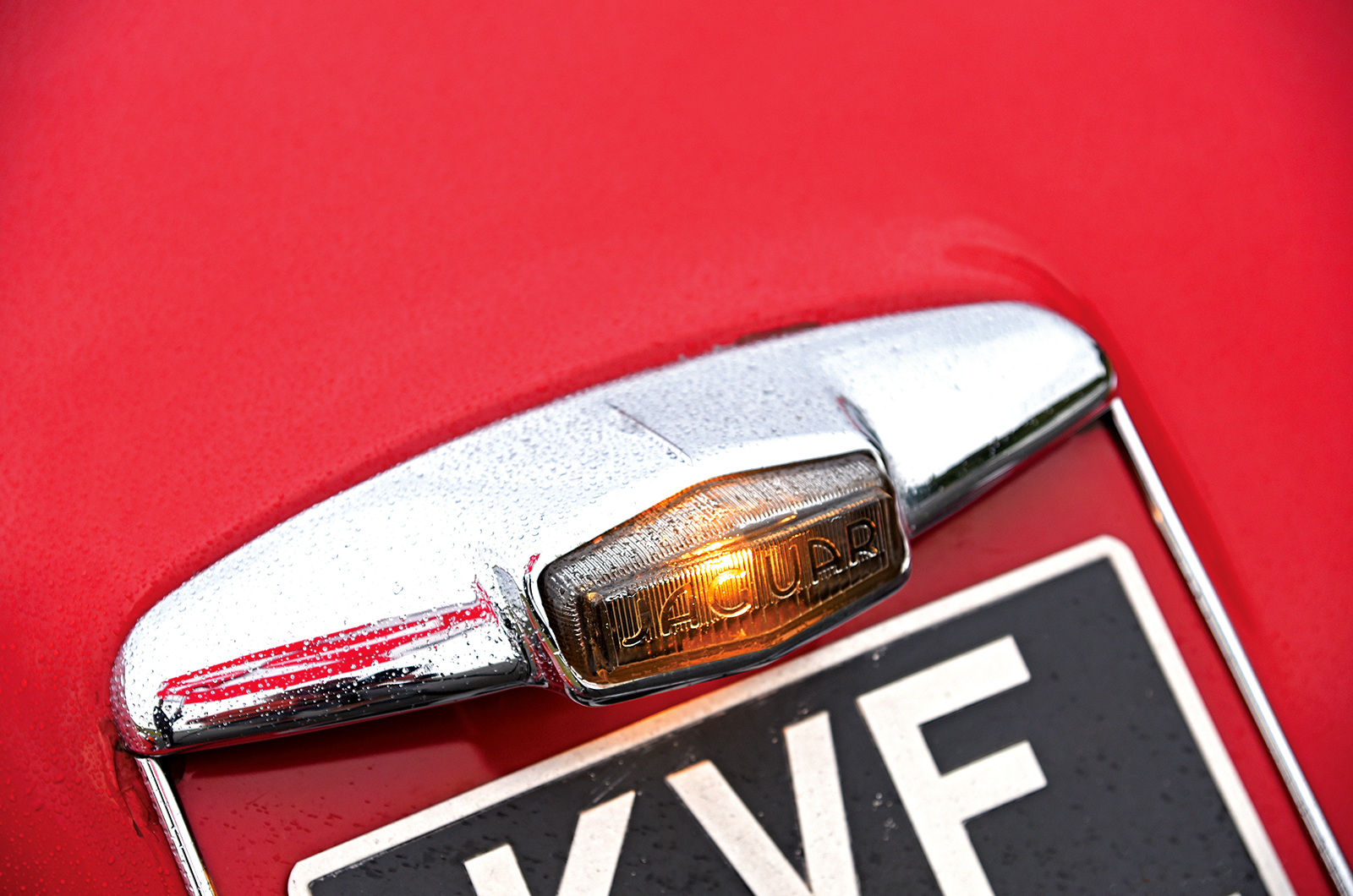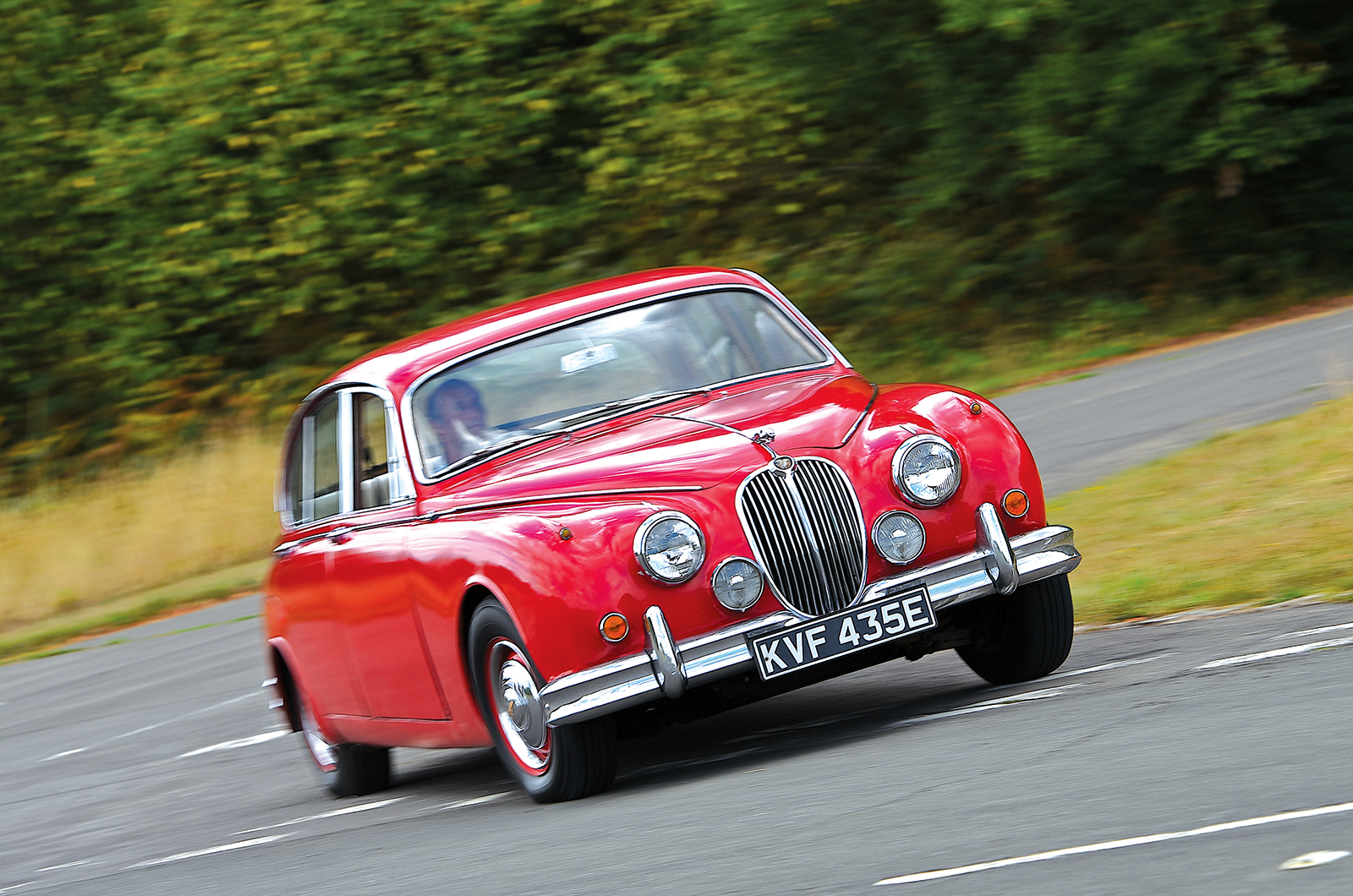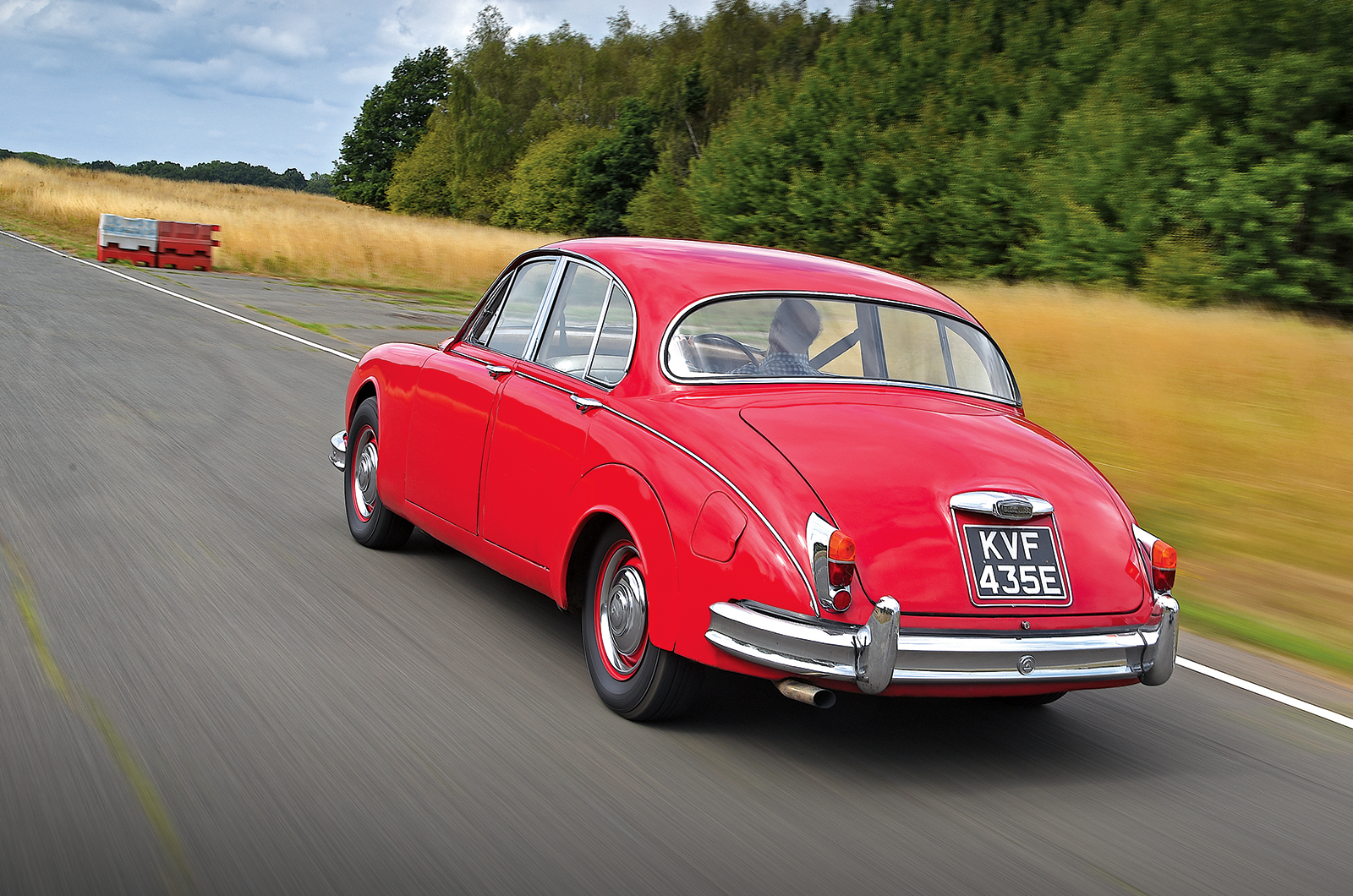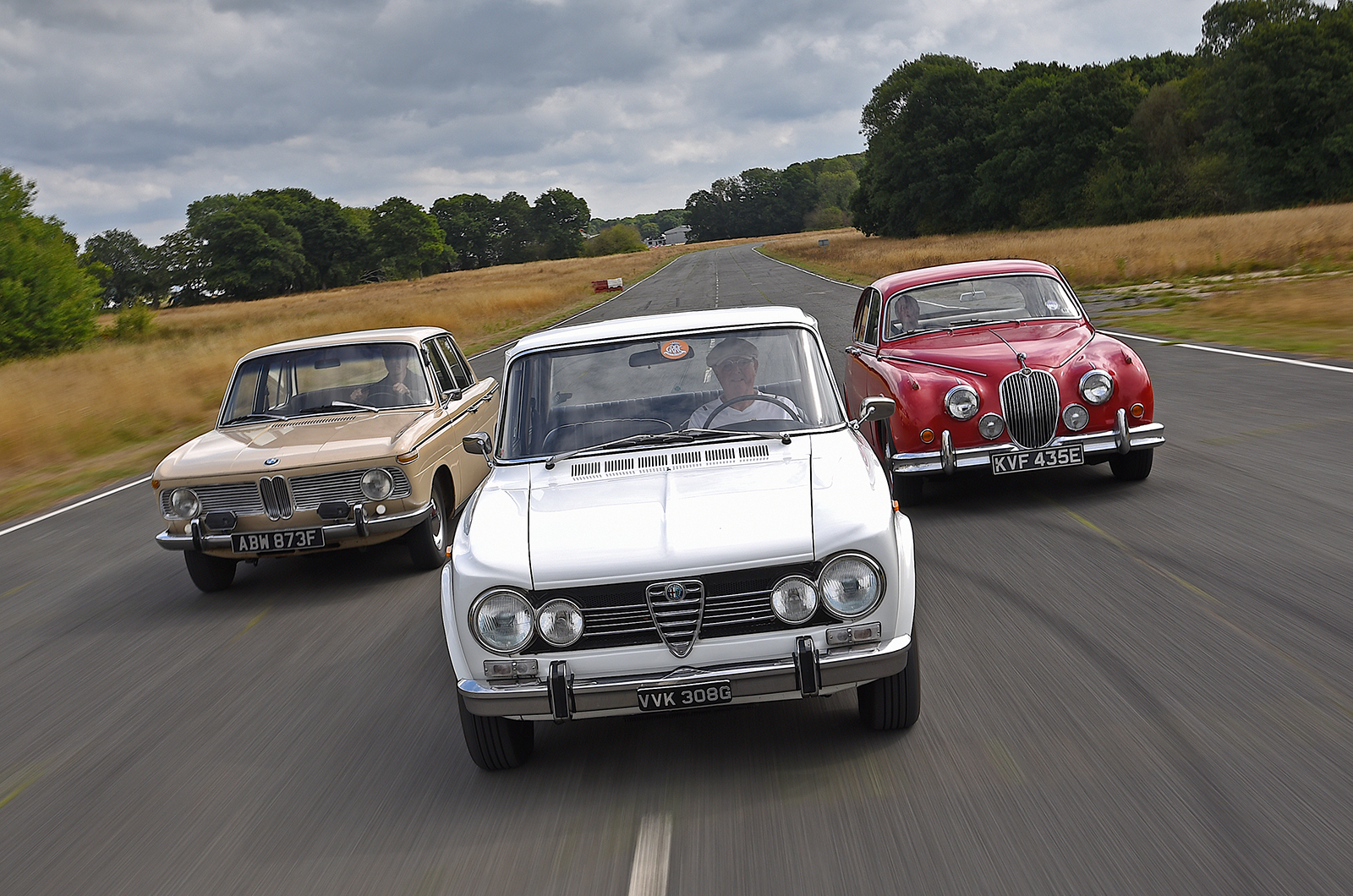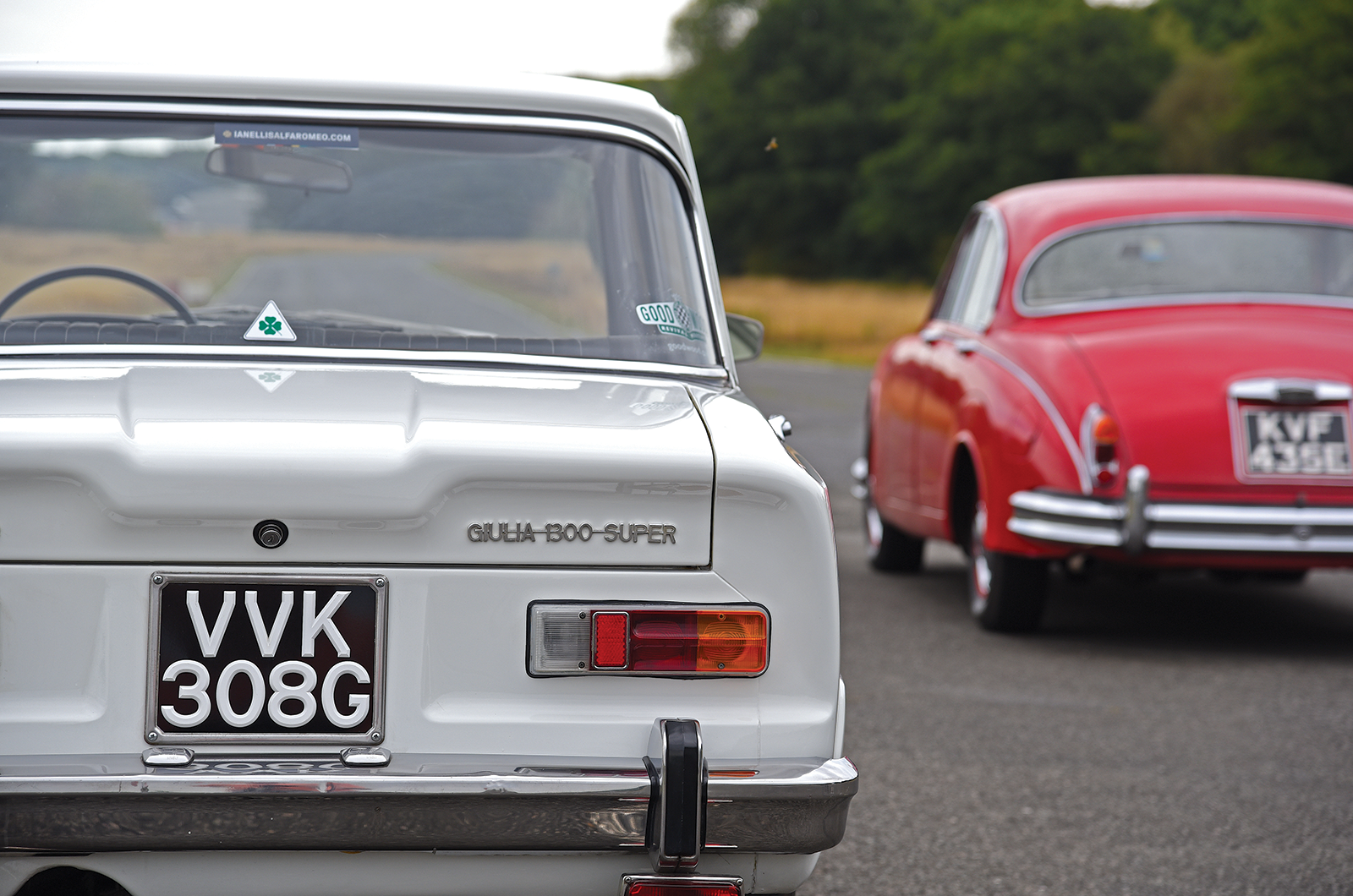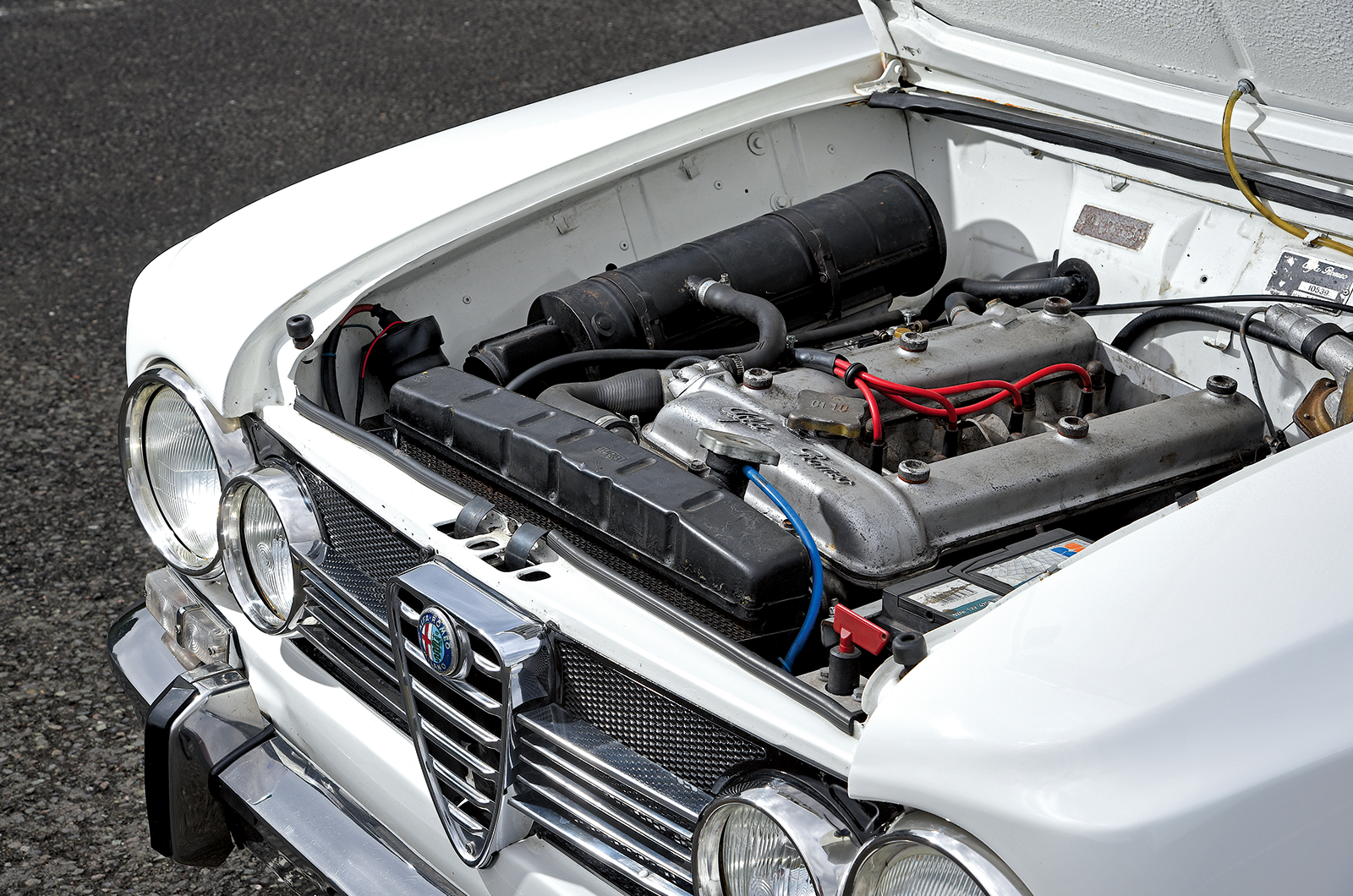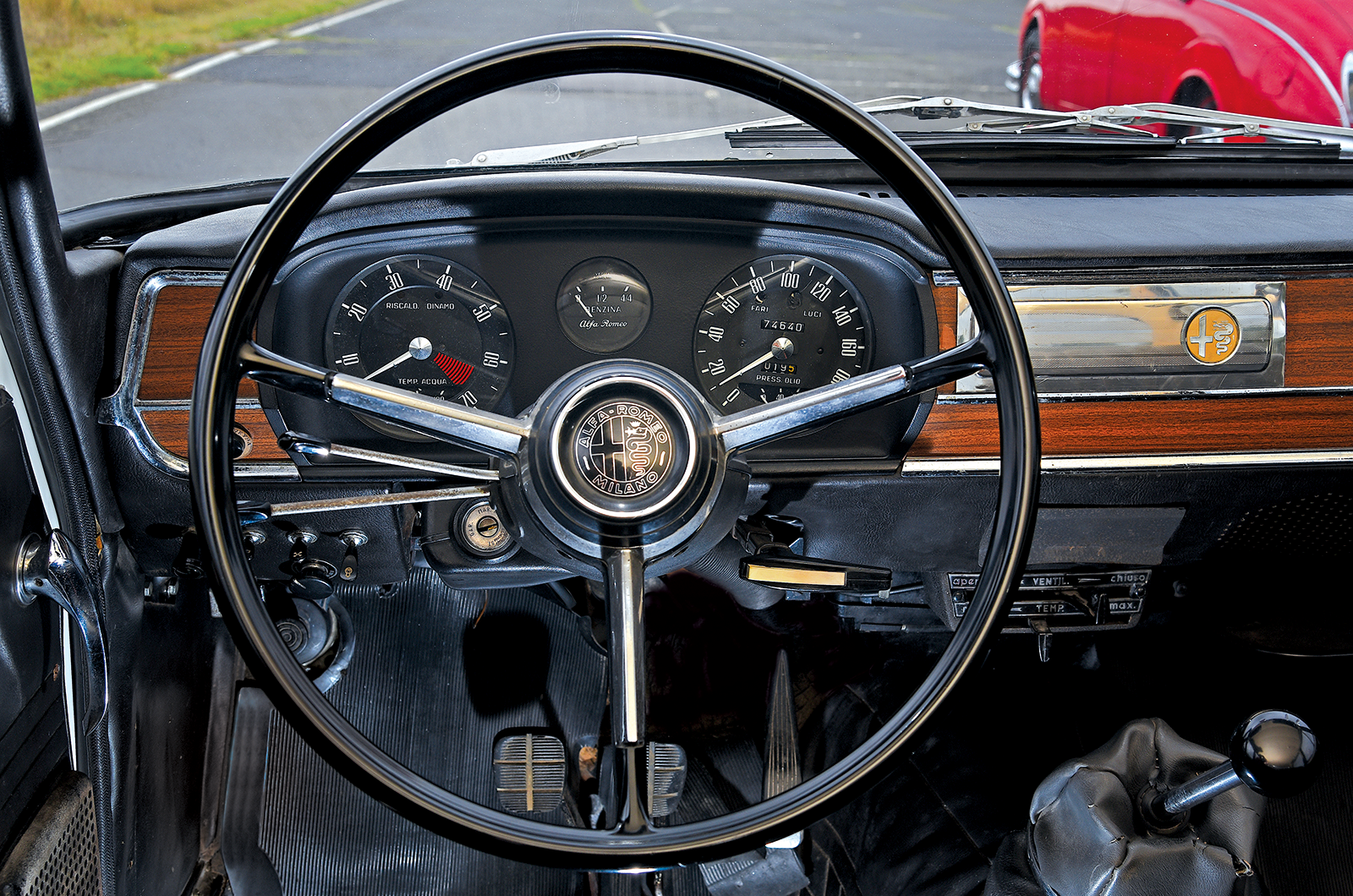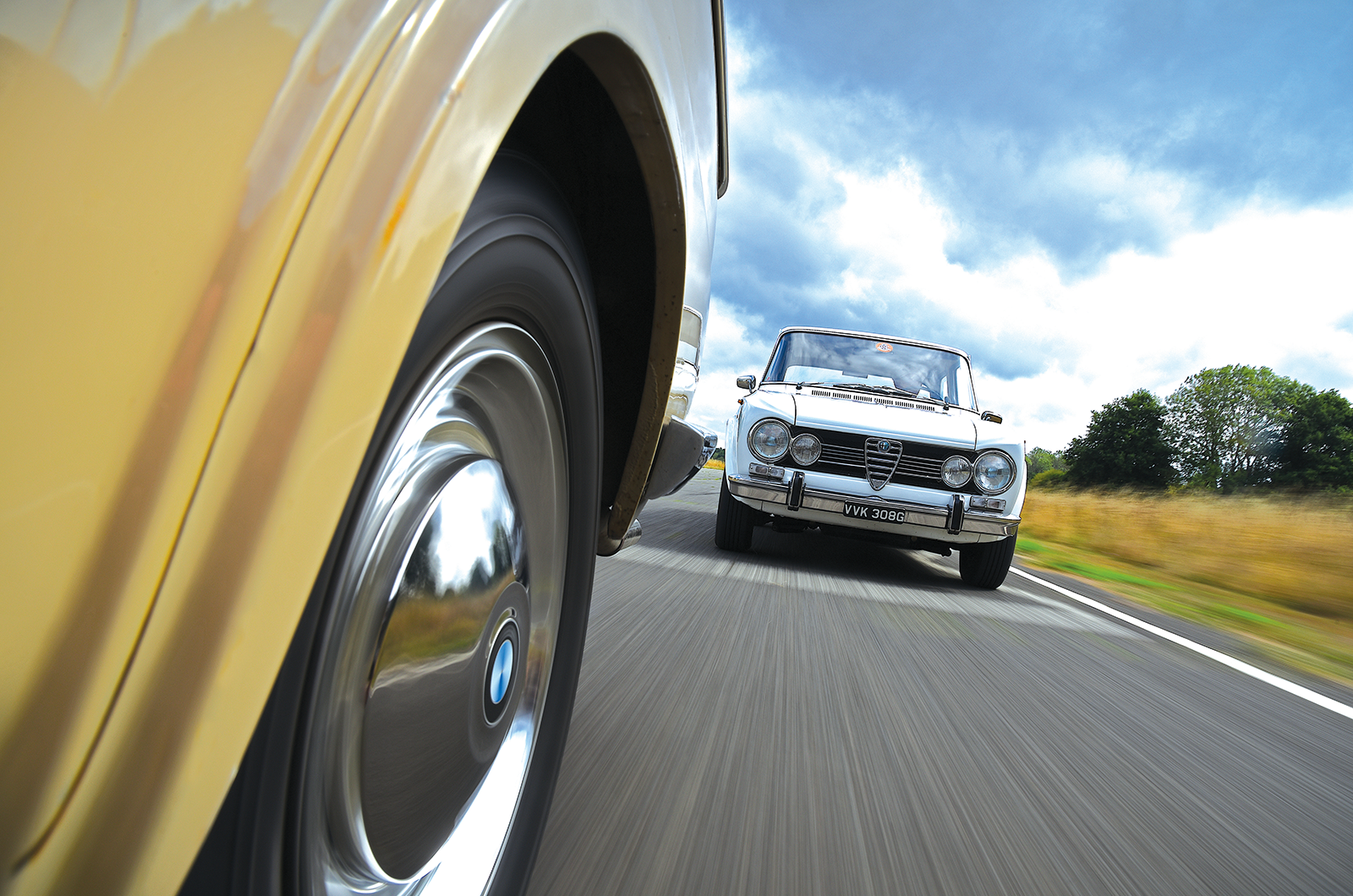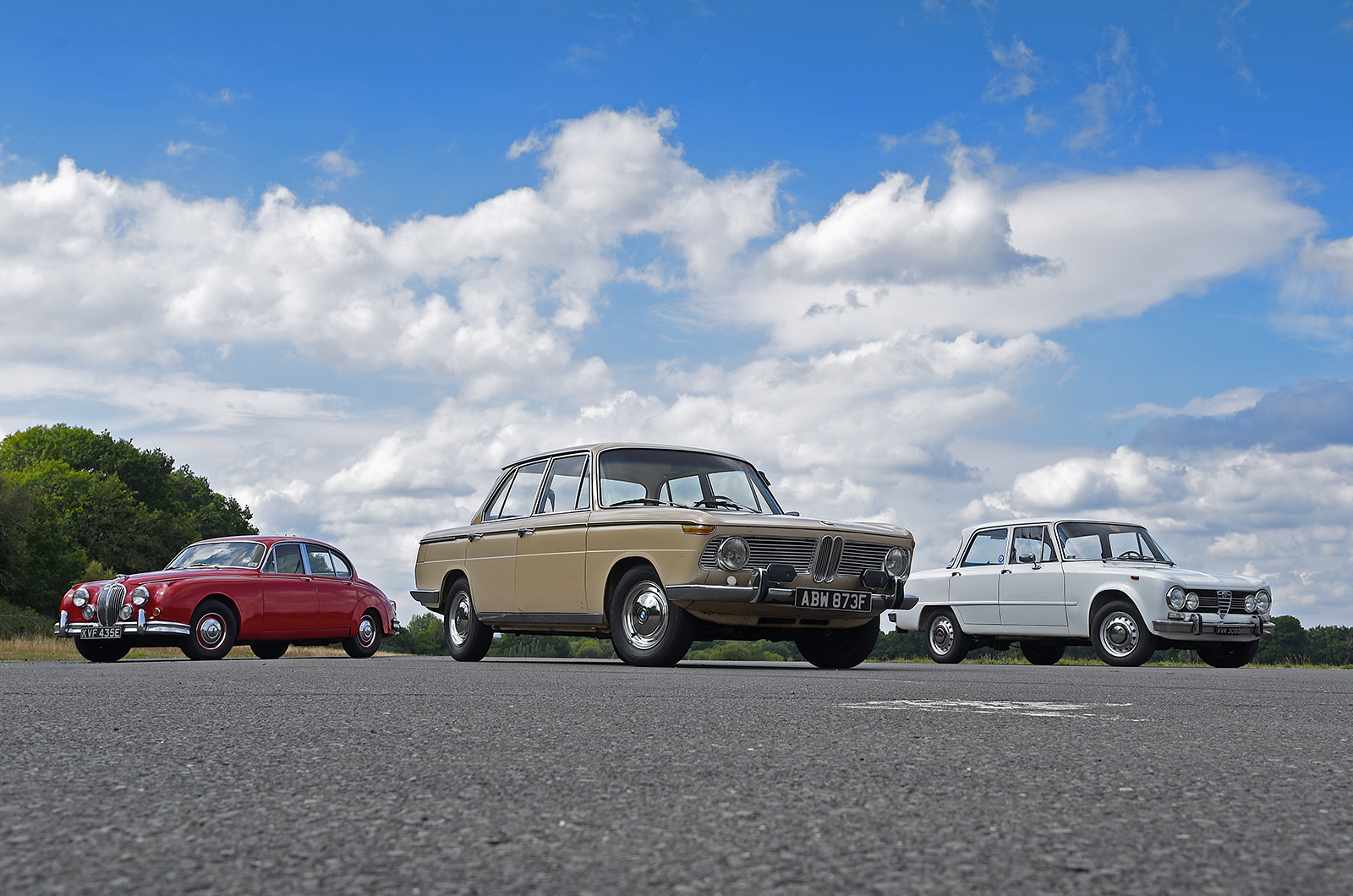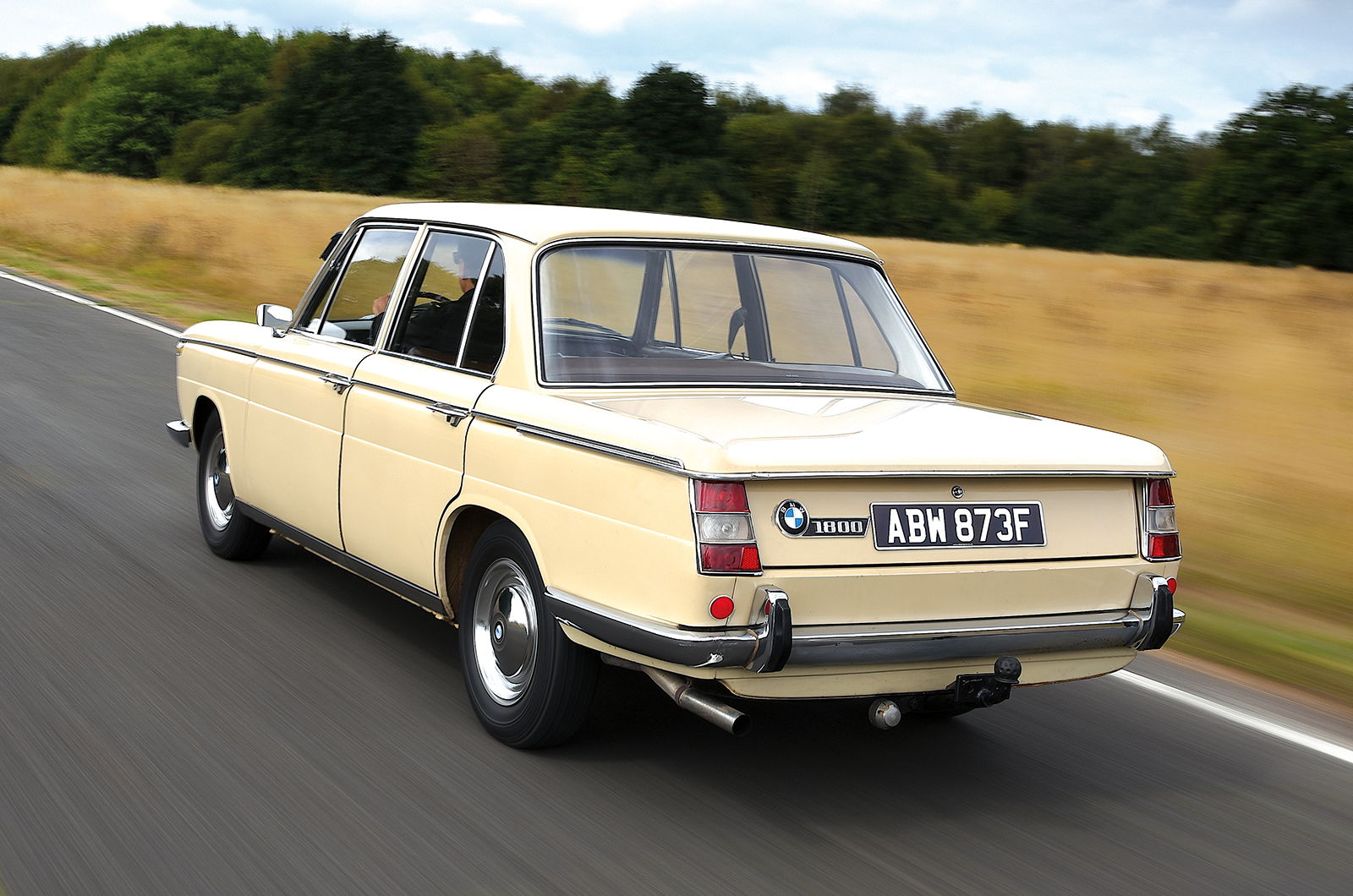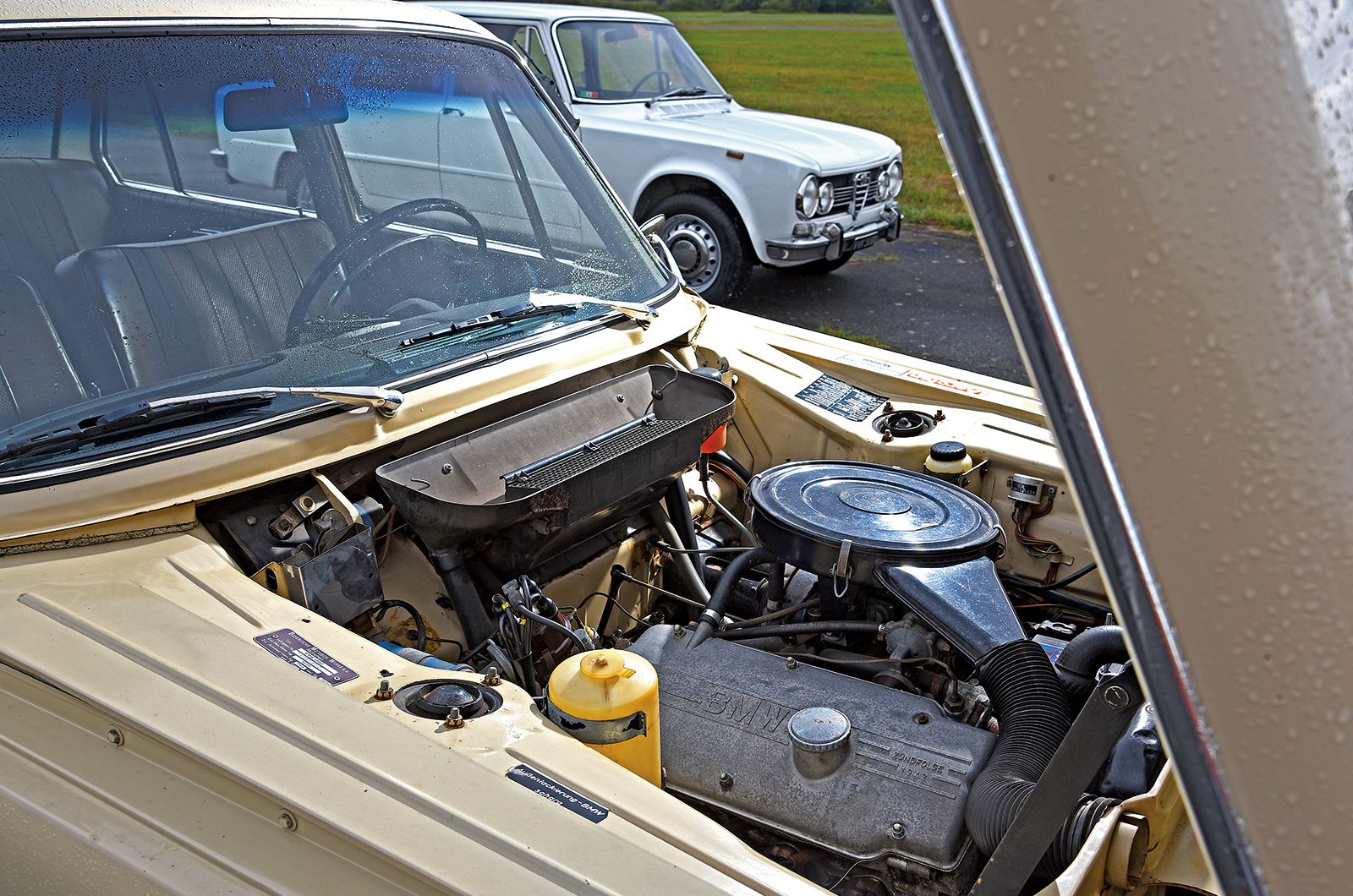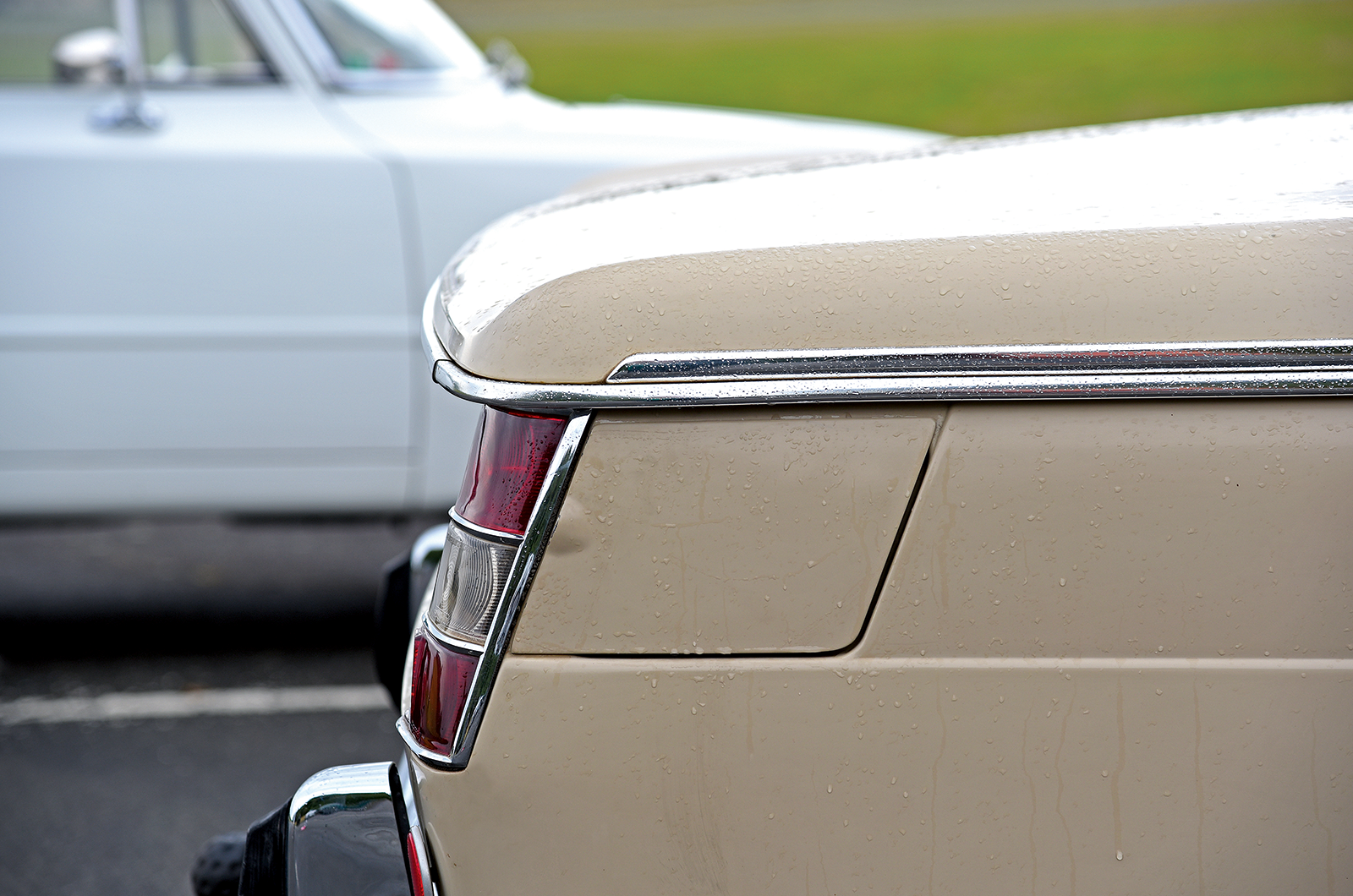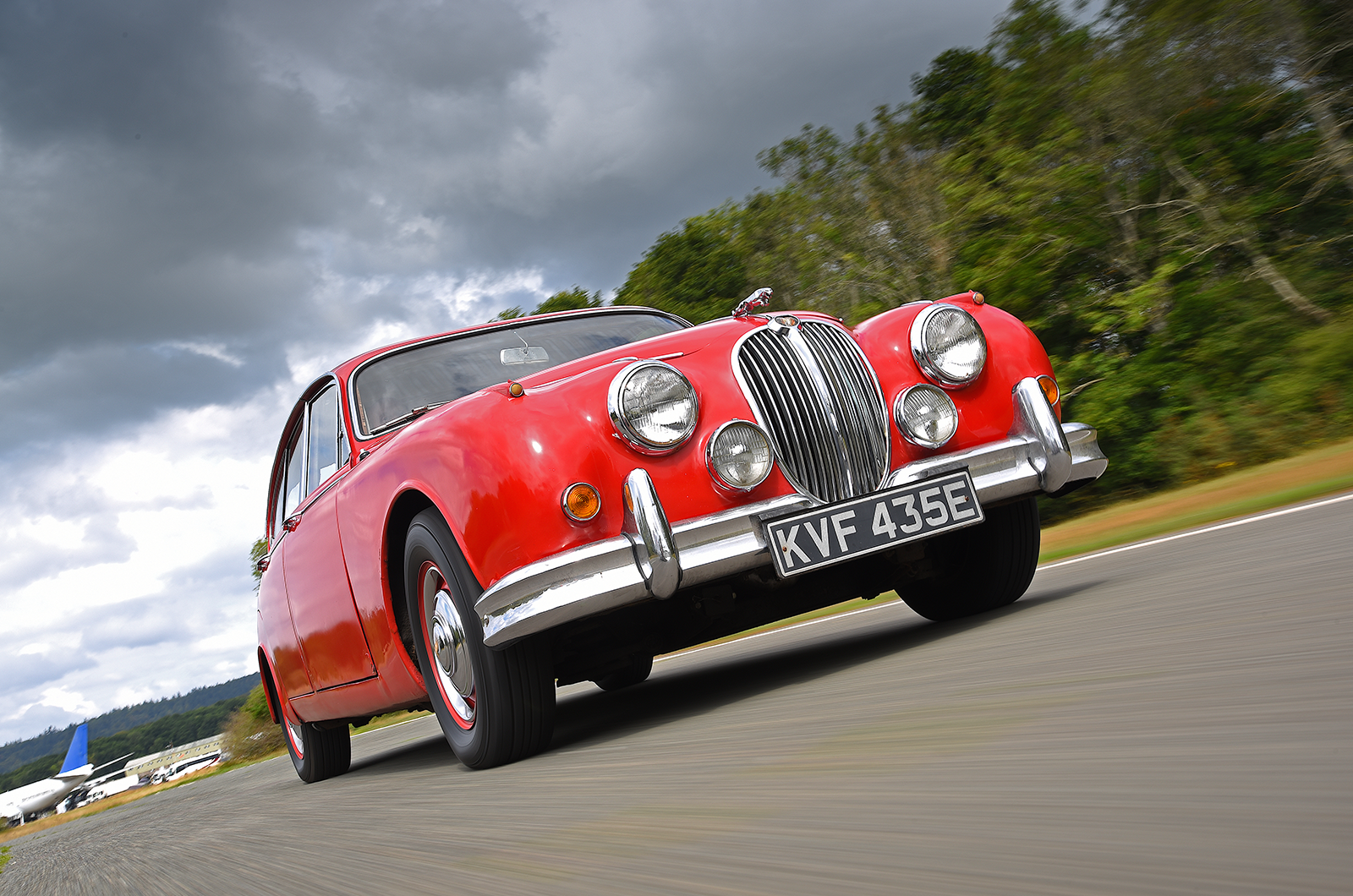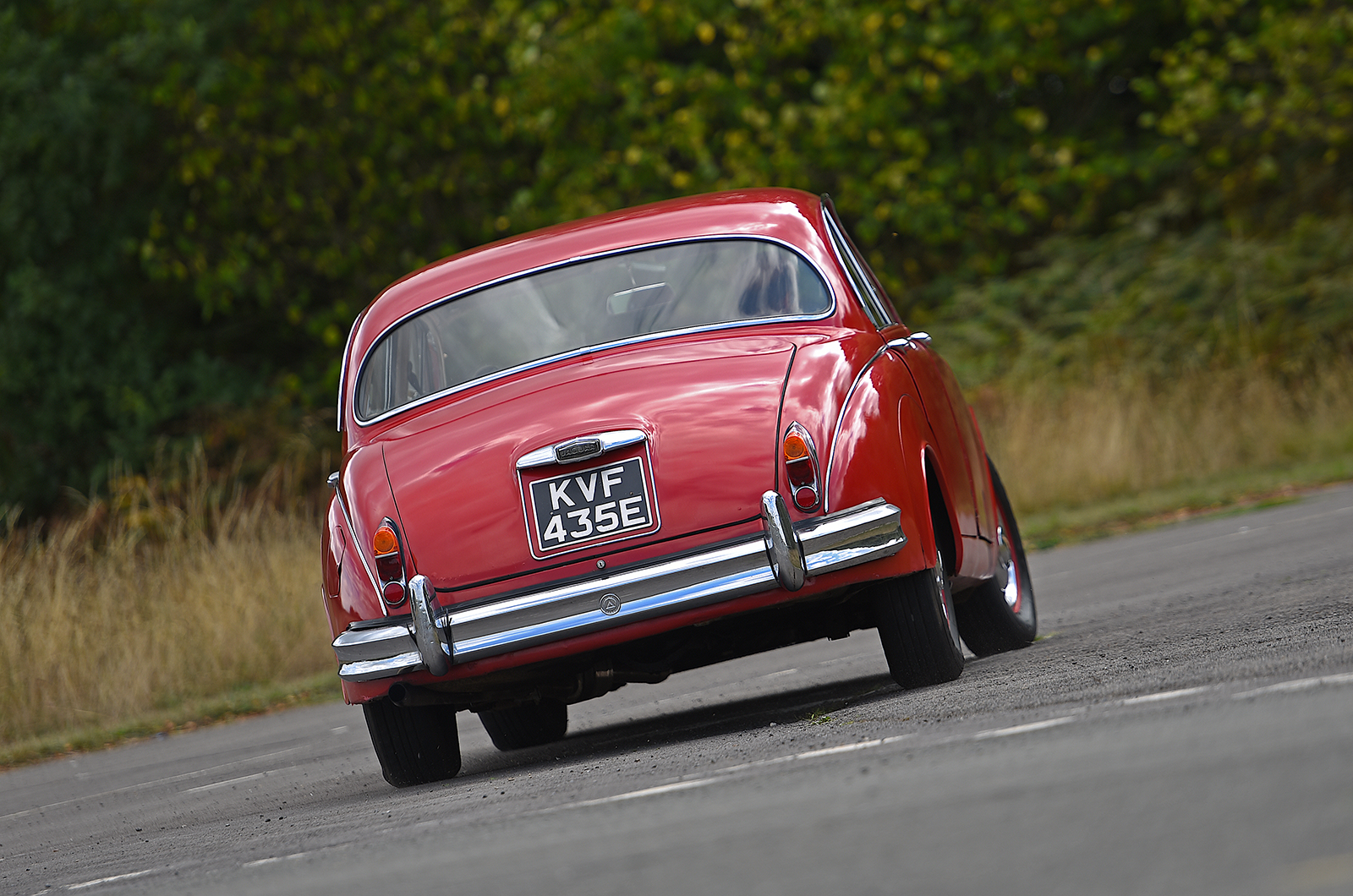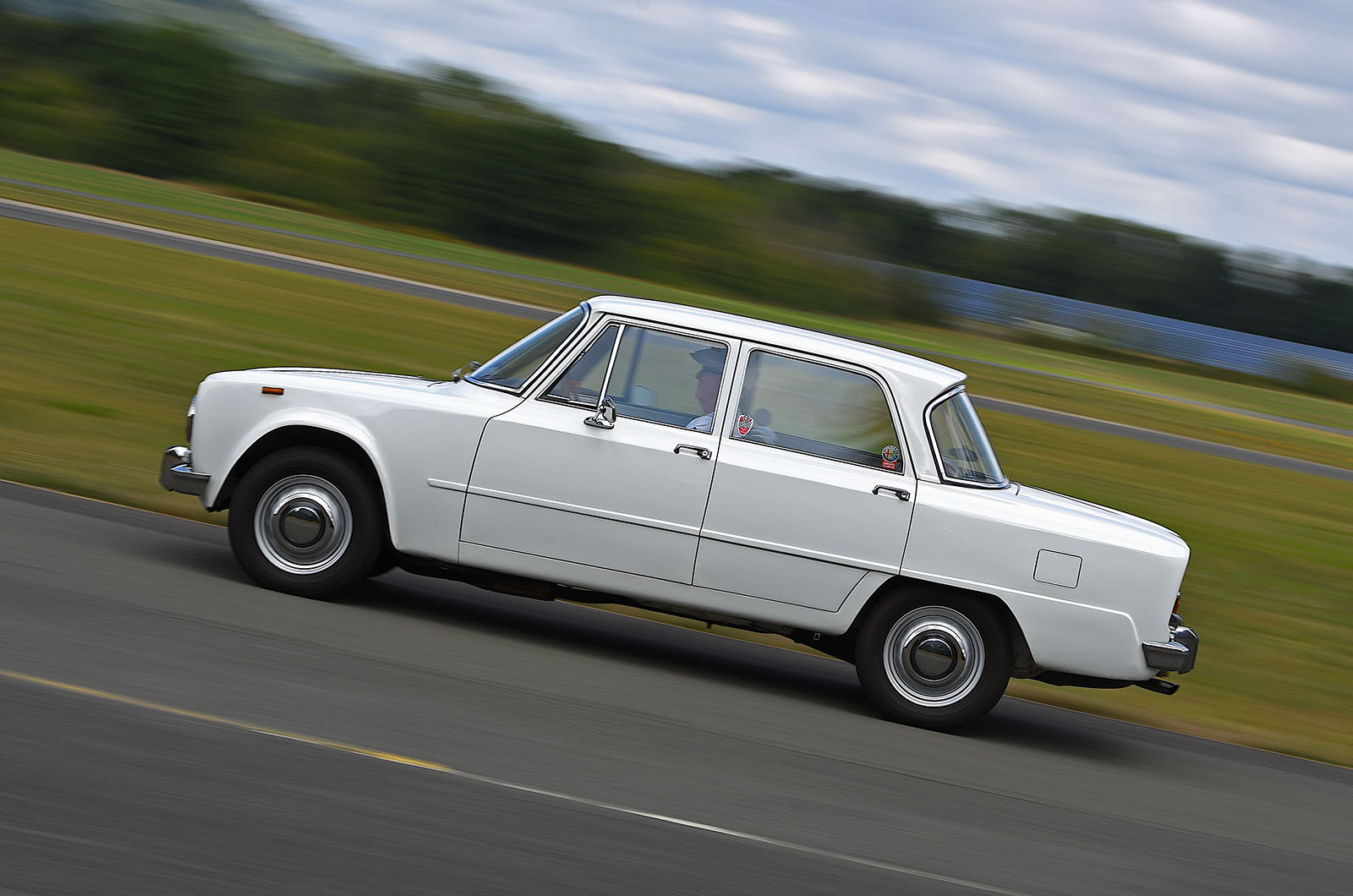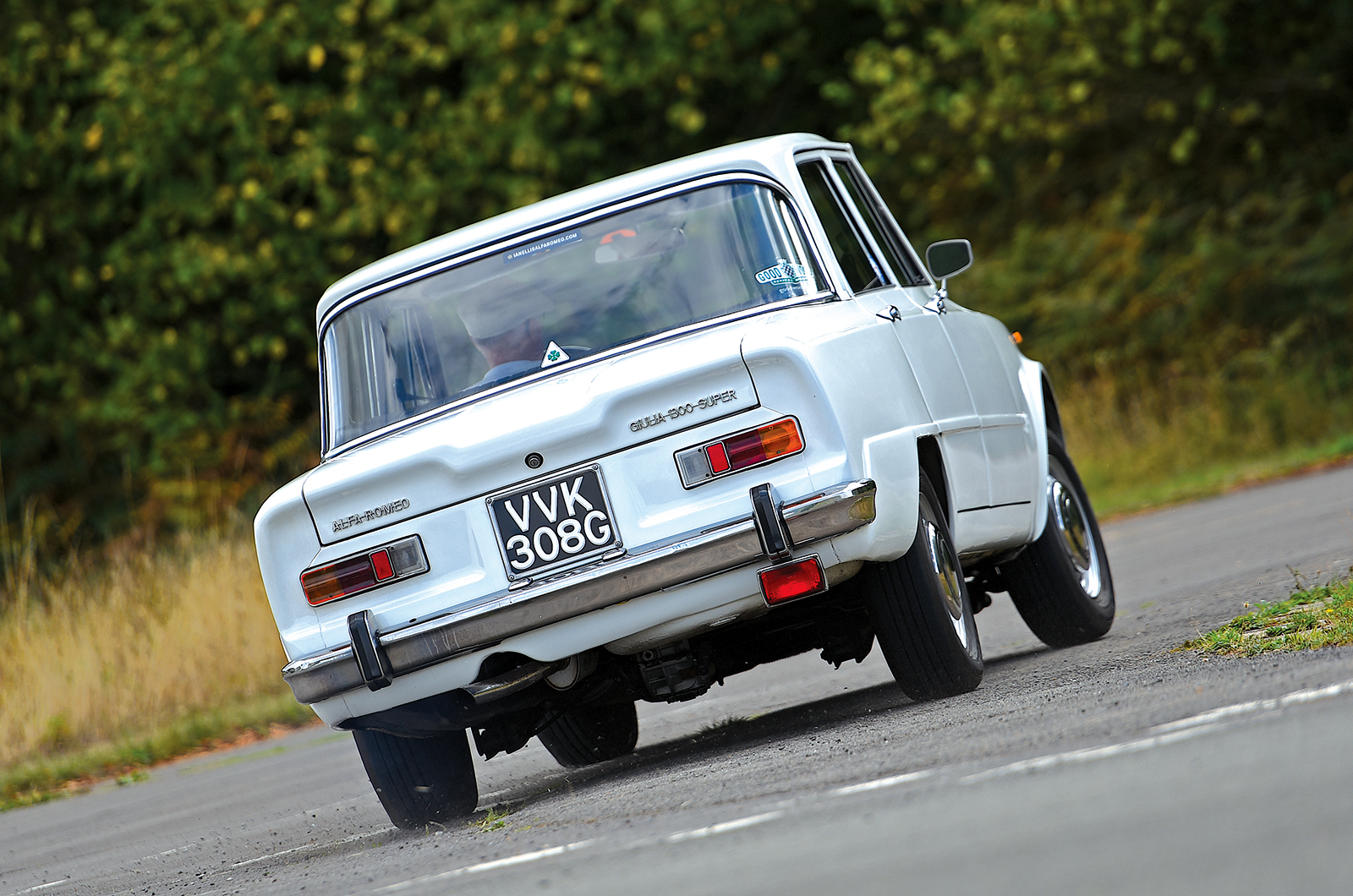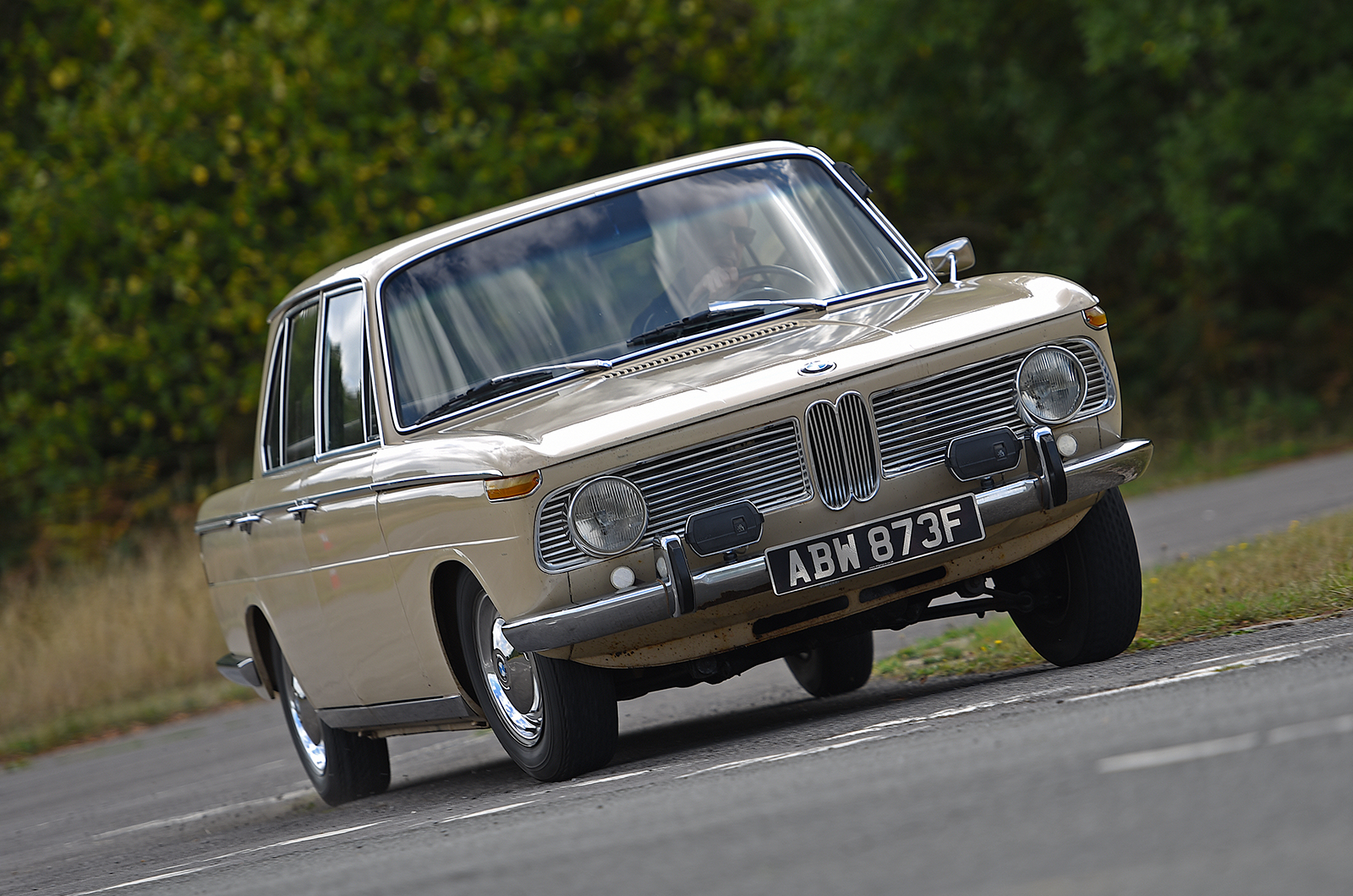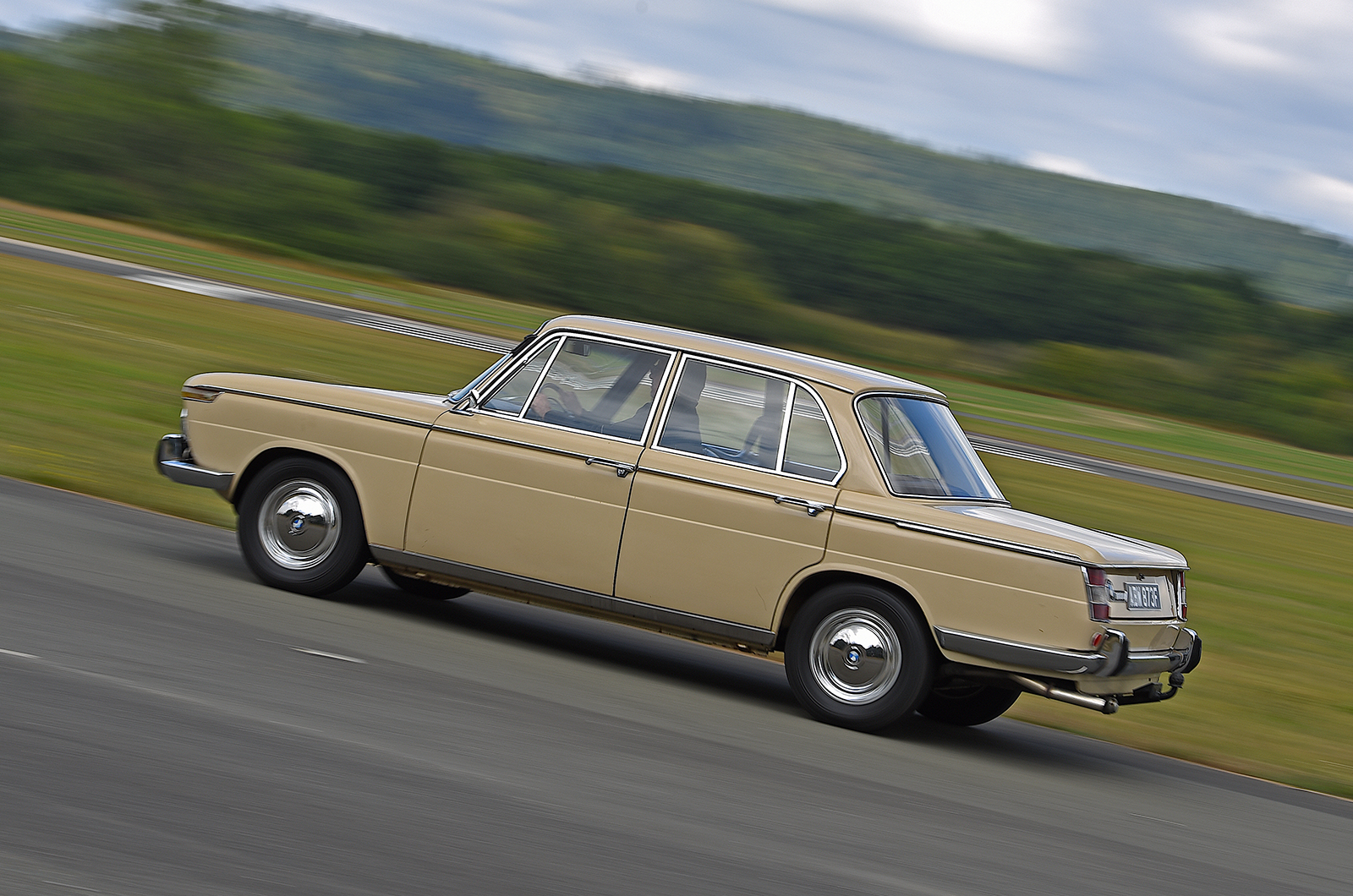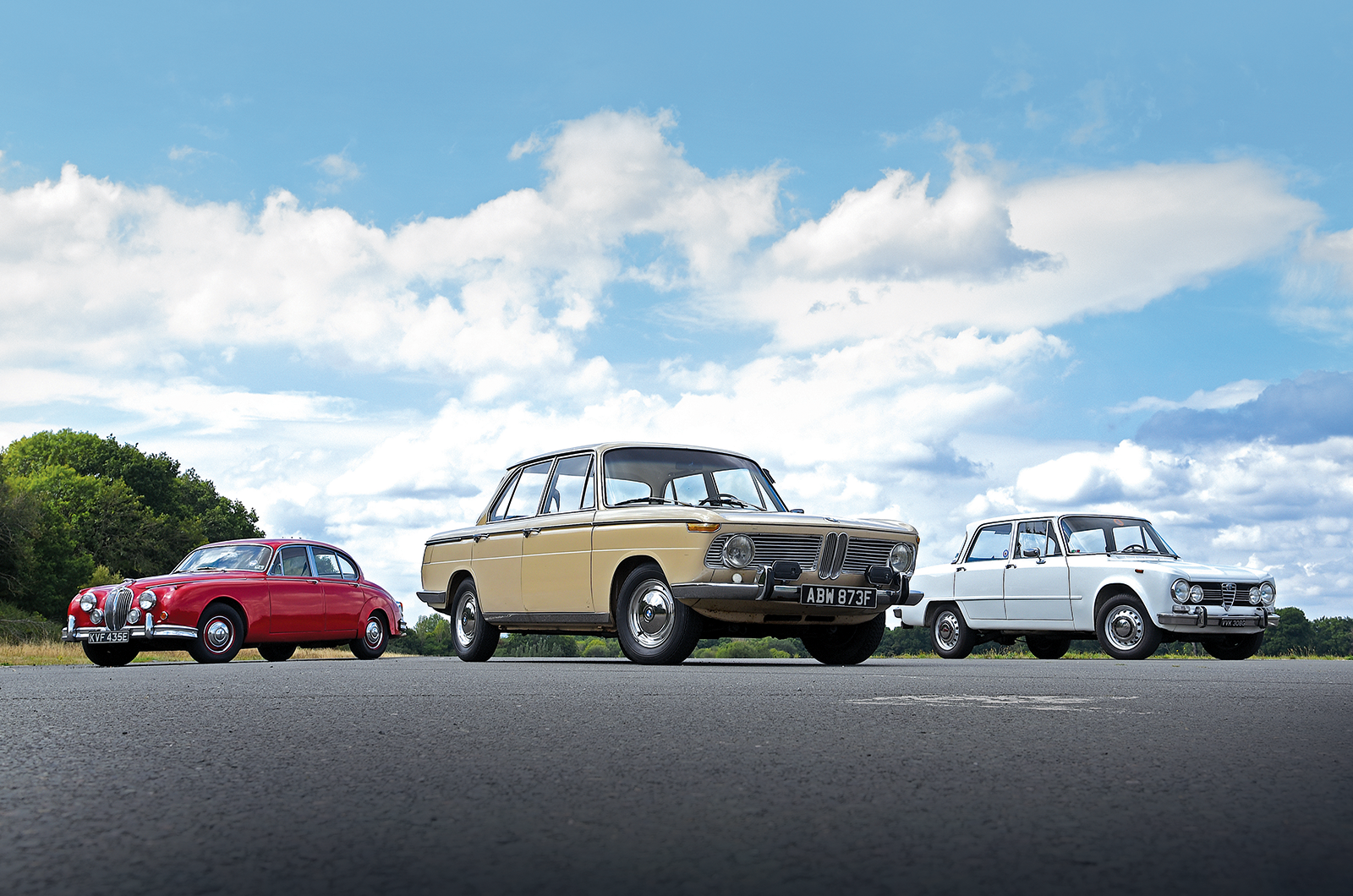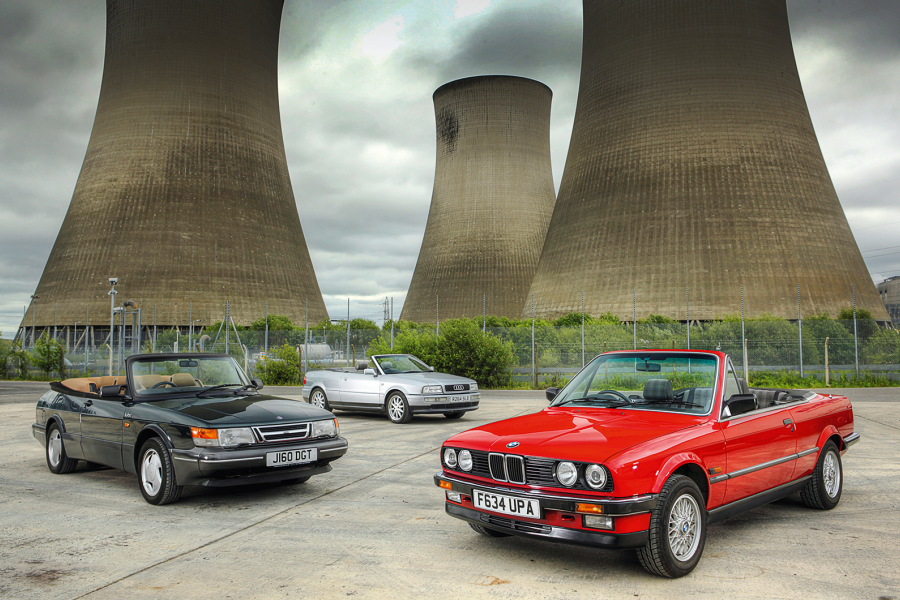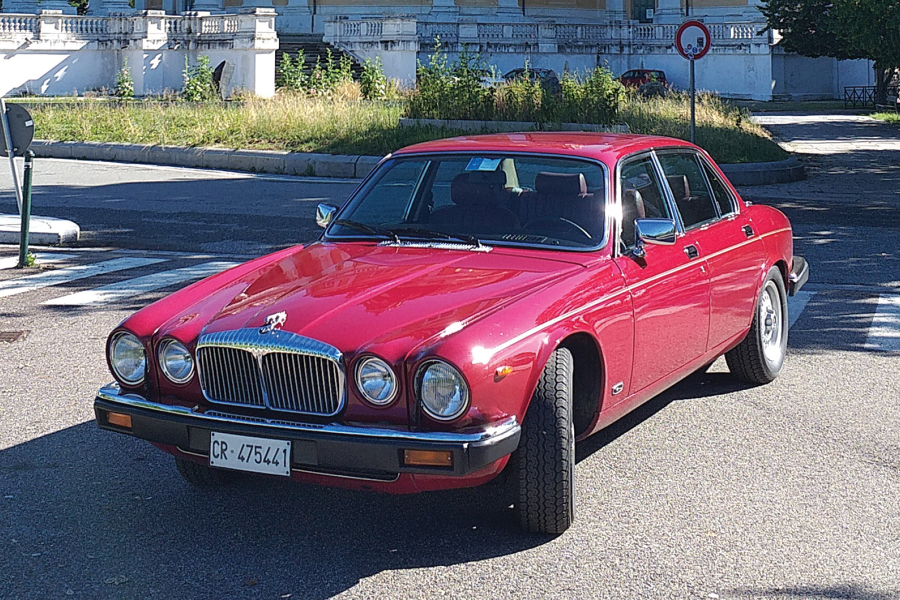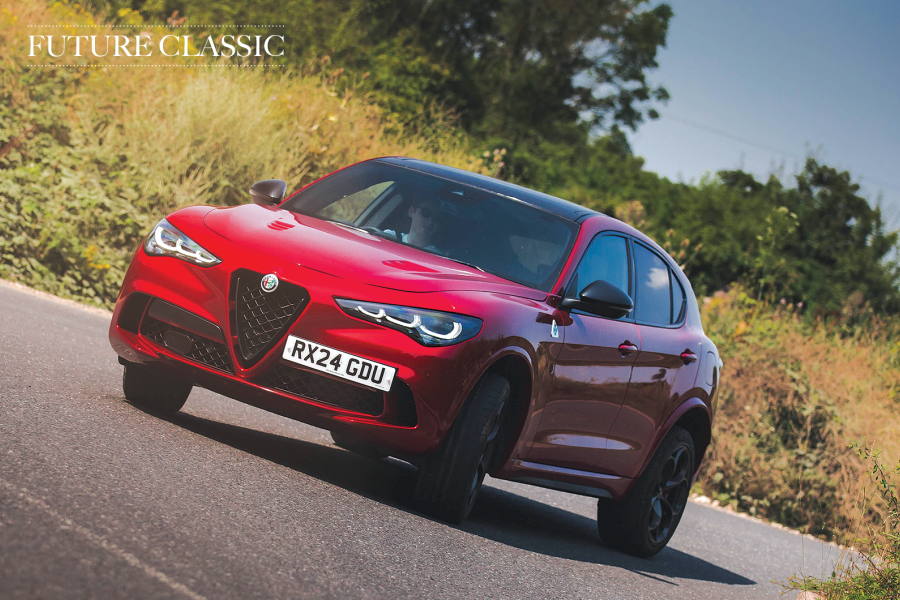It’s the surprise of the three, feeling impressively muscular when, on paper, you’d expect it to be the most dull powerplant
of the trio.
It doesn’t hold a candle to the Alfa’s soundtrack for sure, but it’s such a driveable unit, delivering power at any point in the rev range.
The one disappointment of the 1800 is its gearbox. Perhaps ‘our’ car is in need of new bushings, because BMW went on to produce some superb gearchanges, but the shift quality is closer to a VW Beetle’s than that of an E30 M3.
Although this BMW is fun to throw around, it’s not quite Alfa Romeo-sharp
It’s vague, difficult to navigate and very long of throw – so much so that you end up hitting the base of the driver’s seat when changing into second.
It’s also odd not to see the famous monochromatic instrument layout that BMW introduced with the E3 ‘New Six’ in 1968, and has used in its cars to the present day. Instead, the dials on the Neue Klasse are much more ornate, almost American in style.
It’s a reminder that BMW was still very much forming its identity in the early 1960s, and the marque carried less prestige than either Jaguar or Alfa Romeo.
‘From behind the wheel it has that Munich flair, still feeling like a large, boxy saloon, but eager to kick its tail out and have fun’
Now, just as when it was new, it is the pedigree of the Jaguar name and the Mk2’s traditional looks that inspire many of the plaudits the model receives.
The splendour of the interior and the driveway presence are all that many want from this sort of car, and the Mk2 outstrips the other two in both areas.
In appearance and character, however, the Alfa and BMW are lighter, more youthful, and well ahead.
The BMW’s M10 ‘four’ is impressively flexible
The Jaguar 2.4 would still be your choice for a long motorway journey, but it makes greater sacrifices elsewhere in return for that touring ability.
The other two aren’t significantly less effective cruisers, but their compromises seem smaller, and that’s where their modernity shines.
The Alfa Romeo is the sporting choice, thanks to its lack of weight, effervescent engine and satisfying gearchange, but it’s the BMW that strikes me as the real all-rounder.
Neat details show off the BMW’s high production quality
Nearly as enjoyable a drive as the Giulia, but more refined, more spacious and achieved with simple, easy-to-maintain engineering, it’s a superbly made, spacious family car that’s fun, too.
That the BMW 3 and 5 Series, the successors to the Neue Klasse, have come to define their segment is no surprise – unfortunately for Jaguar, it’s clear why they caught on.
Images: Will Williams
Thanks to: Vintage Motors; William Clapperton; Mike Redmen
Jaguar Mk2, 1959-’69
‘The Jaguar outstrips the others in its driveway presence’
A thorough reworking of the Jaguar 2.4 and 3.4 (retrospectively known as the Mk1), the Mk2 featured all-new – albeit similarly styled – bodywork, as well as a new interior and heavily revised suspension.
The XK straight-six, however, continued largely as it had been in the older car, with only subtle modifications for the 2.4-litre and the addition of a new 3.8-litre version.
Four-wheel disc brakes, optional on the Mk1, were now standard on all models and after just three years the Mk2 had become Jaguar’s record seller, with 108,850 cars built in total including the Daimler-badged versions, which were fitted with Edward Turner’s 2.5-litre V8.
This 2.4-litre Jaguar has significant touring ability
In 1967, the model range was renamed to comprise the 240 and 340, with the 3.8-litre available only by special order.
The power of the 2.4 was boosted at the same time, while slimmer bumpers were the main external change.
Cost-saving measures, including front foglights becoming an optional extra and a switch from standard leather to Ambla upholstery, had occurred just prior to these changes introduced for the last two years of production.
Alfa Romeo Giulia, 1962-’76
The Alfa Romeo 1300 TI feels light on its feet
The 105-series Giulia saloon wasn’t just Alfa Romeo’s most successful model to date, with 542,085 of all variants built and spawning the Spider, the GT series of coupés and the 1750/2000 Berlina, but proved the basis of Alfa Romeo’s identity for the rest of the 20th century.
Based on the running gear of the Giulietta saloon, the Giulia incorporated crucial changes to make the car less of a specialist product – no longer did the suspension need regular greasing, while great strides were made in improving refinement.
The styling not only looked fresh, but the boxy four-door was deceptively aerodynamic thanks to the benefit of wind-tunnel testing, with a Cd of 0.33 – as good as many cars on sale today.
The 105-series Giulia saloon was the foundation for Alfa Romeo’s future
The range was launched as the TI with a 1.6-litre engine, soon joined by a 1.3-litre, with the 1300 TI proving the most popular model and accounting for nearly half of all Giulia saloon production.
There was significant simplification to the front and rear bodywork for the 1974 Nuova, while a 55bhp Perkins diesel engine was fitted to 6582 of these final cars.
BMW ‘Neue Klasse’, 1962-’75
The BMW’s competent chassis allows you to exploit the 1.8-litre M10 engine
BMW cut a confused image prior to the Neue Klasse range, building licensed copies of the Italian Isetta, its extremely expensive (and loss-inducing) 501 and 507, and a tiny economy car, the 700.
But with this fresh model range the firm found the identity it is known for today.
An all-new design with a new engine to boot, the Neue Klasse made its debut as the 1500, though the 1800 soon joined the line-up and proved the most successful version.
The 1600, 1800Ti, 1800TiSA, 2000 and 2000Ti models followed. In all, 348,681 were built.
The BMW’s boxy shape contains excellent packaging
The Neue Klasse spawned the ’02 series, a shortened two-door version, and these models proved crucial in establishing BMW in America and other key export markets.
The car’s design language would also inspire the ‘New Six’ range of saloons, known to enthusiasts as the E3.
These three ranges would, in subsequent generations, become known as the 3, 5 and 7 Series.
Factfiles
Jaguar Mk2 2.4
- Sold/number built 1959-’67/25,173
- Construction steel monocoque
- Engine iron-block, alloy-head, dohc 2483cc straight-six, twin Solex carburettors
- Max power 120bhp @ 5750rpm
- Max torque 144Ib ft @ 2000rpm
- Transmission four-speed manual, optional overdrive, RWD
- Suspension: front independent, by double wishbones, coils, anti-roll bar rear live axle, quarter-elliptic leaf springs, radius arms, Panhard rod; telescopic dampers f/r
- Steering recirculating ball
- Brakes discs
- Length 15ft 1in (4597mm)
- Width 5ft 7in (1695mm)
- Height 4ft 10in (1460mm)
- Wheelbase 8ft 11in (2717mm)
- Weight 3100Ib (1406kg)
- 0-60mph 17.3 secs
- Top speed 96mph
- Mpg 18-28
- Price new £1342 (1967)
- Price now £8-20,000*
BMW 1800
- Sold/number built 1963-’71/134,814
- Construction steel monocoque
- Engine iron-block, alloy-head, ohc 1773cc ‘four’, single Solex carburettor
- Max power 90bhp @ 5250rpm
- Max torque 106lb ft @ 3000rpm
- Transmission four-speed manual, RWD
- Suspension independent, at front by MacPherson struts rear semi-trailing arms, coil springs, telescopic dampers
- Steering worm and roller
- Brakes discs front, drums rear
- Length 14ft 11in (4546mm)
- Width 5ft 7in (1710mm)
- Height 4ft 9in (1448mm)
- Wheelbase 8ft 5in (2565mm)
- Weight 2417Ib (1098kg)
- 0-60mph 13.7 secs
- Top speed 100mph
- Mpg 25-35
- Price new £1498 (1967)
- Price now £10-20,000*
Alfa Romeo 1300 TI
- Sold/number built 1966-’72/c200,000
- Construction steel monocoque
- Engine all-alloy, dohc 1290cc ‘four’, single Solex carburettor
- Max power 85bhp @ 6000rpm
- Max torque 77Ib ft @ 4900rpm
- Transmission five-speed manual, RWD
- Suspension independent, at front by double wishbones with anti-roll bar rear trailing arms, coil springs; telescopic dampers f/r
- Steering recirculating ball
- Brakes discs front, drums rear
- Length 13ft 6in (4140mm)
- Width 5ft 1in (1560mm)
- Height 4ft 8in (1430mm)
- Wheelbase 8ft 2in (2510mm)
- Weight 2160Ib (980kg)
- 0-60mph 13.3 secs
- Top speed 99mph
- Mpg 25-35
- Price new £1321 (1967)
- Price now £12-25,000*
*Prices correct at date of original publication
Enjoy more of the world’s best classic car content every month when you subscribe to C&SC – get our latest deals here
READ MORE
Restoring grandad’s Jaguar XK140
Putting Munich on the map: BMW 2002 and 3.0 CSL
Buyer’s guide: Alfa Romeo Giulia
Charlie Calderwood
Charlie Calderwood is Classic & Sports Car’s Features Editor
